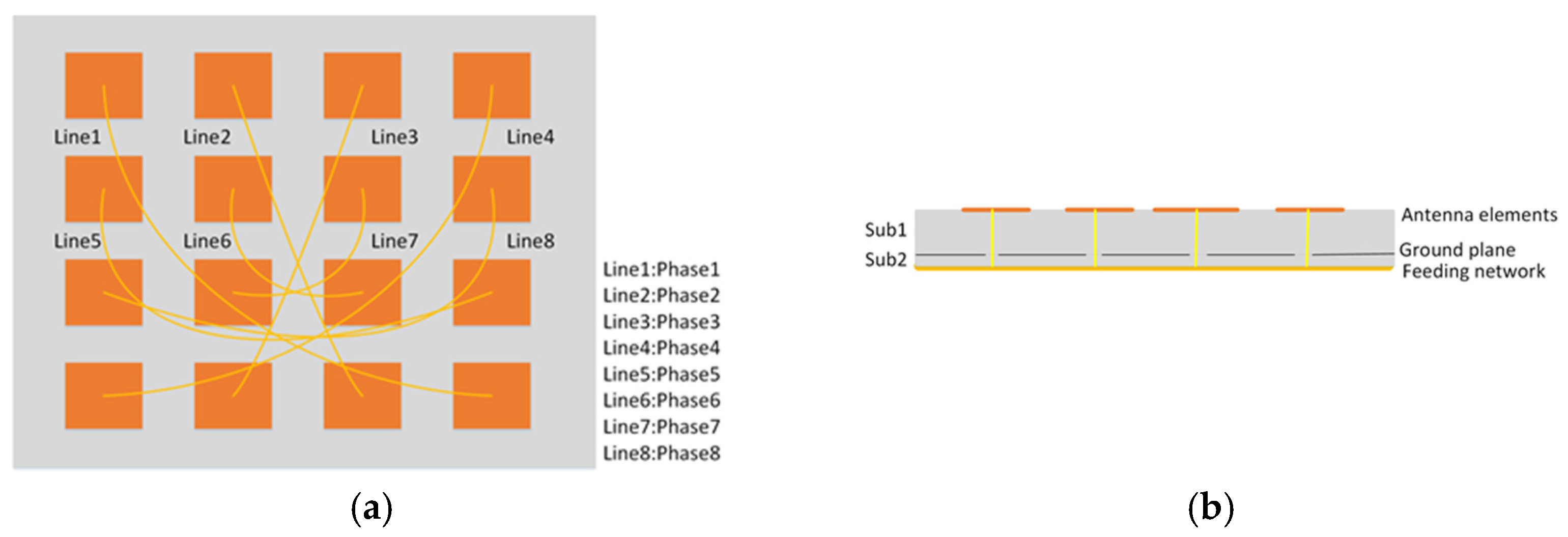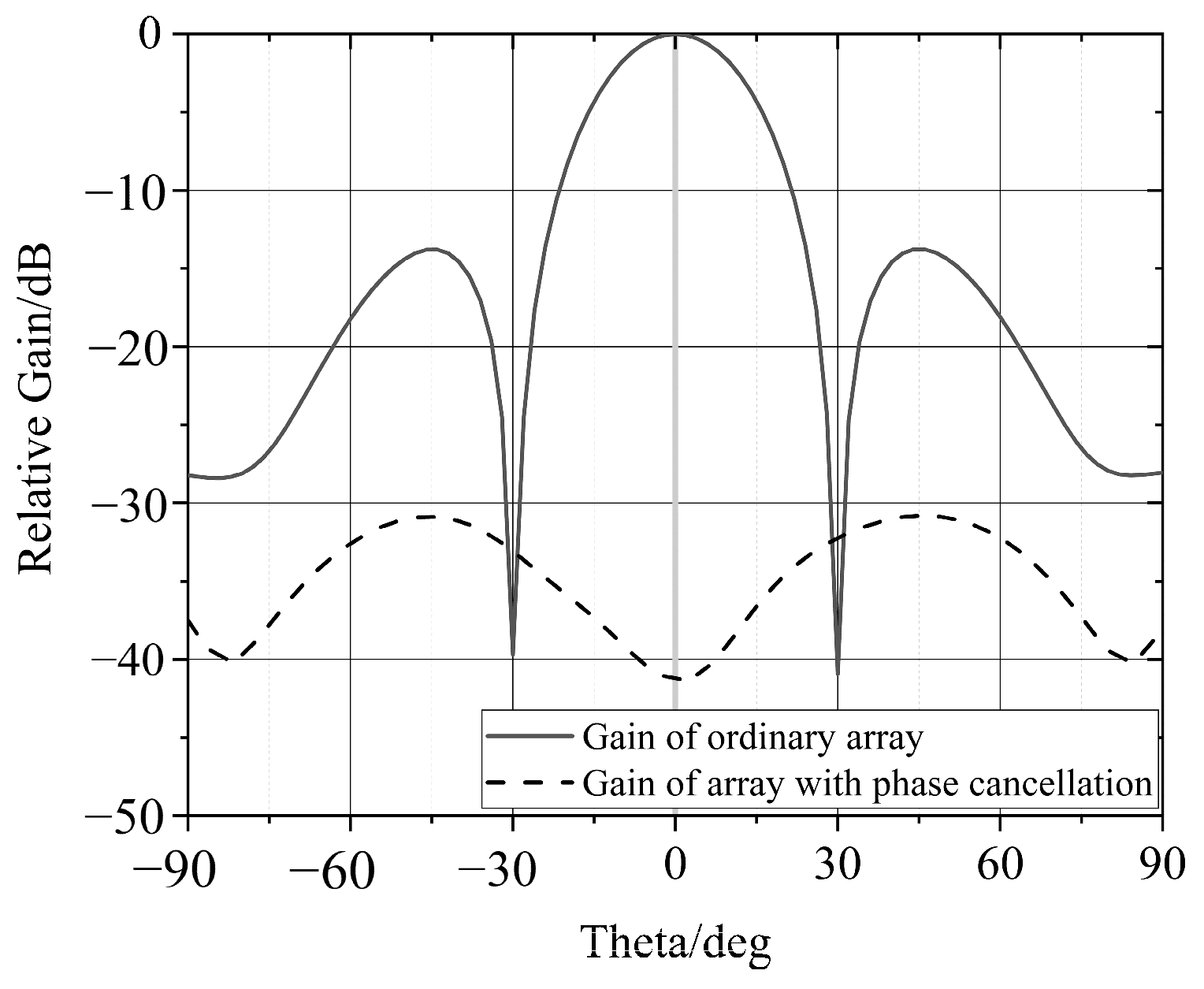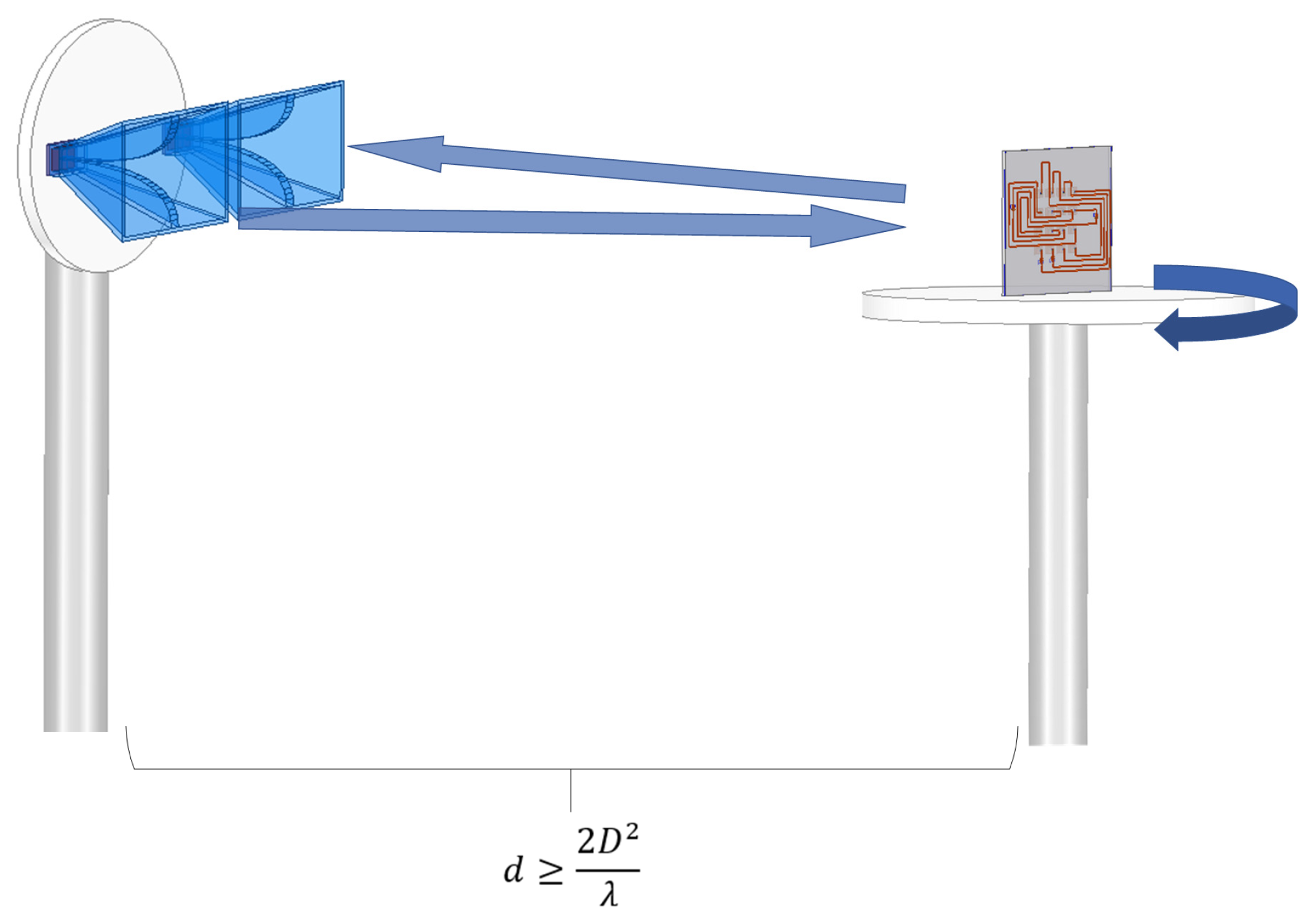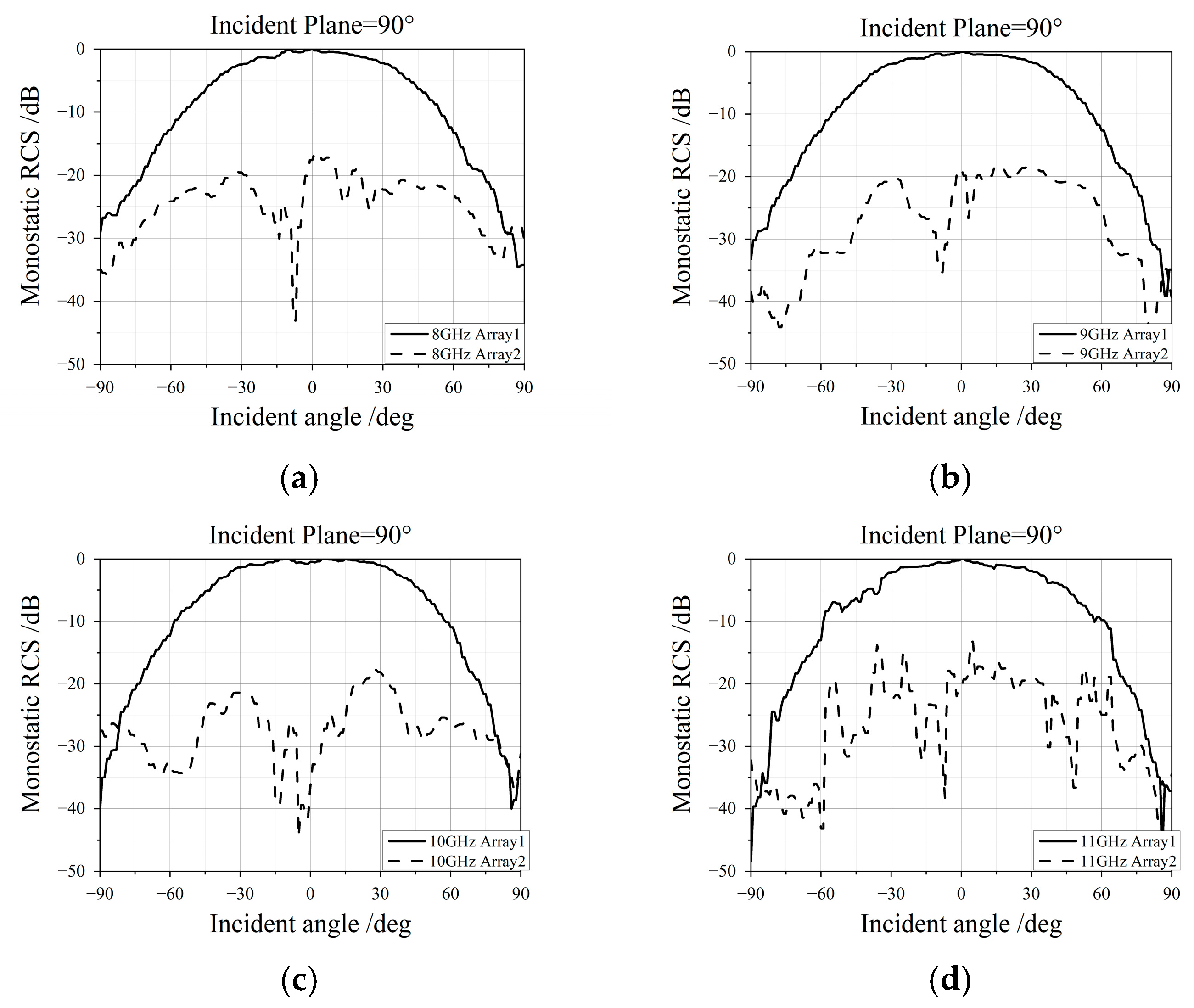A Low-RCS 2D Multi-Layer Van Atta Array at X-Band
Abstract
:1. Introduction
2. Theory and Design
3. Measurement Setup and Results
4. Conclusions
Author Contributions
Funding
Institutional Review Board Statement
Informed Consent Statement
Data Availability Statement
Conflicts of Interest
References
- El-Hakim, H.A.; Mahmoud, K.R. A Comparative Study between Different Approaches to Improve the RCS of a Compact Double-Layer Absorber. J. Inst. 2017, 12, P10022. [Google Scholar] [CrossRef]
- Gong, Y.-X.; Zhou, Z.-X.; Jiang, J.-T.; Zhao, H.-J. Design of Ultra Wideband Microwave Absorber Effectual for Objects of Arbitrary Shape. Chin. Phys. B 2015, 24, 124101. [Google Scholar] [CrossRef]
- Venneri, F.; Costanzo, S.; Borgia, A. A Dual-Band Compact Metamaterial Absorber with Fractal Geometry. Electronics 2019, 8, 879. [Google Scholar] [CrossRef]
- Libimol, V.A.; Aanandan, C.K. Checker Board HIS with Defected Ground Structure for Positive Reflection Phase Gradient and Wideband RCS Reduction. In Proceedings of the 2016 International Conference on Next Generation Intelligent Systems (ICNGIS), Kottayam, India, 1–3 September 2016; pp. 1–3. [Google Scholar]
- Sievenpiper, D.; Zhang, L.; Broas, R.F.J.; Alexopolous, N.G.; Yablonovitch, E. High-Impedance Electromagnetic Surfaces with a Forbidden Frequency Band. IEEE Trans. Microw. Theory Tech. 1999, 47, 2059–2074. [Google Scholar] [CrossRef]
- Zaker, R.; Sadeghzadeh, A. Passive Techniques for Target Radar Cross Section Reduction: A Comprehensive Review. Int. J. RF Microw. Comput.-Aided Eng. 2020, 30, e22411. [Google Scholar] [CrossRef]
- Wang, F.; Li, K.; Ren, Y.; Zhang, Y. A Novel Reconfigurable FSS Applied to the Antenna Radar Cross Section Reduction. Int. J. RF Microw. Comput.-Aided Eng. 2019, 29, e21729. [Google Scholar] [CrossRef]
- Nourinia, J.; Ghobadi, C.; Mohammadi, B.; Mahmoud, A.; Aryanian, I. RCS Reduction of Reflectarray Antenna Backed with Sub-Wavelength Frequency Selective Surface. In Proceedings of the 2019 27th Iranian Conference on Electrical Engineering (ICEE), Yazd, Iran, 30 April 2019–2 May 2019; pp. 1627–1631. [Google Scholar]
- Zainud-Deen, S.H.; Malhat, H.A.E.-A.; Shabayek, N.A. Reconfigurable RCS Reduction from Curved Structures Using Plasma Based FSS. Plasmonics 2020, 15, 341–350. [Google Scholar] [CrossRef]
- Anwar, R.S.; Mao, L.; Ning, H. Frequency Selective Surfaces: A Review. Appl. Sci. 2018, 8, 1689. [Google Scholar] [CrossRef]
- Paquay, M.; Iriarte, J.-C.; Ederra, I.; Gonzalo, R.; de Maagt, P. Thin AMC Structure for Radar Cross-Section Reduction. IEEE Trans. Antennas Propag. 2007, 55, 3630–3638. [Google Scholar] [CrossRef]
- Zheng, W.-B.; Song, W.; Sheng, X.-Q. A Broadband AMC-Based Reflector for RCS Reduction. In Proceedings of the 2017 International Applied Computational Electromagnetics Society Symposium (ACES), Suzhou, China, 1–4 August 2017; pp. 1–2. [Google Scholar]
- Xue, J.; Jiang, W.; Gong, S. Chessboard AMC Surface Based on Quasi-Fractal Structure for Wideband RCS Reduction. IEEE Antennas Wirel. Propag. Lett. 2018, 17, 201–204. [Google Scholar] [CrossRef]
- Sang, D.; Chen, Q.; Ding, L.; Guo, M.; Fu, Y. Design of Checkerboard AMC Structure for Wideband RCS Reduction. IEEE Trans. Antennas Propag. 2019, 67, 2604–2612. [Google Scholar] [CrossRef]
- Zaker, R.; Sadeghzadeh, A. A Low-Profile Design of Polarization Rotation Reflective Surface for Wideband RCS Reduction. IEEE Antennas Wirel. Propag. Lett. 2019, 18, 1794–1798. [Google Scholar] [CrossRef]
- Lu, Y.; Su, J.; Liu, J.; Guo, Q.; Yin, H.; Li, Z.; Song, J. Ultrawideband Monostatic and Bistatic RCS Reductions for Both Copolarization and Cross Polarization Based on Polarization Conversion and Destructive Interference. IEEE Trans. Antennas Propag. 2019, 67, 4936–4941. [Google Scholar] [CrossRef]
- Xing, Z.; Yang, F.; Yang, P.; Yang, J. A Low-RCS and Wideband Circularly Polarized Array Antenna Co-Designed with a High-Performance AMC-FSS Radome. IEEE Antennas Wirel. Propag. Lett. 2022, 21, 1659–1663. [Google Scholar] [CrossRef]
- Kim, Y.; Lee, W.; Yoon, Y.J. Mono-Static RCS Reduction Using Modified van Atta Array. In Proceedings of the 2013 IEEE Antennas and Propagation Society International Symposium (APSURSI), Orlando, FL, USA, 7–13 July 2013; pp. 1222–1223. [Google Scholar]
- Song, K.; Feng, D.; Wang, J.; Xie, Q.; Liu, L. Phase Modulation of Retro-Reflected Radar Echo Signal Using a Microstrip Van-Atta Array. IEEE Access 2019, 7, 96011–96018. [Google Scholar] [CrossRef]
- Yau, K.S.B. Planar Multi-Layer Passive Retrodirective Van Atta Array Reflectors at X-Band. In Proceedings of the 2015 International Symposium on Antennas and Propagation (ISAP), Hobart, TAS, Australia, 9–12 November 2015; pp. 1–4. [Google Scholar]
- Farzami, F.; Khaledian, S.; Smida, B.; Erricolo, D. Erricolo Reconfigurable Dual-Band Bidirectional Reflection Amplifier with Applications in Van Atta Array. IEEE Trans. Microw. Theory Tech. 2017, 65, 4198–4207. [Google Scholar] [CrossRef]
- Fujita, M.; Murakami, C. Experimental Study of a Polarization-Rotating Van Atta Array with Reduced Co-Polarized Radar Cross-Section. In Proceedings of the IGARSS 2003, 2003 IEEE International Geoscience and Remote Sensing Symposium, Proceedings (IEEE Cat. No.03CH37477), Toulouse, France, 21–25 July 2003; Volume 7, pp. 4503–4505. [Google Scholar]










| Methods | Ref. | Frequency (GHz) | RCS Reduction Level | Incident Angles | Bandwidth | Angle Independence |
|---|---|---|---|---|---|---|
| absorbing material | [2] | 2–18 | −10 dB | ±30° | wideband | no |
| [3] | 0.878 and 0.965 | −25 dB | not mentioned | narrowband | no | |
| FSS, AMC, and PRRS | [11] | 15–15.4 | −20 dB | ±15° | narrowband | no |
| [13] | 5.4–14.2 | −10 dB | ±10° | wideband | no | |
| [14] | 3.77–10.14 | −10 dB | ±20° | wideband | no | |
| [16] | 7.5–22.5 | −10 dB | ±30° | wideband | no | |
| [17] | 4–18 GHz | −13.7 dB | ±25° | wideband | no | |
| Van Atta array | [18] | not mentioned | −25 dB | over ± 40° | narrowband | yes |
| [19] | 9.75–10.75 | not mentioned | large range angle | narrowband | yes | |
| proposed array | - | 8–11 | −20 dB | maximum ± 90° | wideband | yes |
| Transmission Lines Number | Phase [deg] |
|---|---|
| line1 | 180 |
| line2 | 180 |
| line3 | 0 |
| line4 | 0 |
| line5 | 180 |
| line6 | 0 |
| line7 | 180 |
| line8 | 0 |
Disclaimer/Publisher’s Note: The statements, opinions and data contained in all publications are solely those of the individual author(s) and contributor(s) and not of MDPI and/or the editor(s). MDPI and/or the editor(s) disclaim responsibility for any injury to people or property resulting from any ideas, methods, instructions or products referred to in the content. |
© 2023 by the authors. Licensee MDPI, Basel, Switzerland. This article is an open access article distributed under the terms and conditions of the Creative Commons Attribution (CC BY) license (https://creativecommons.org/licenses/by/4.0/).
Share and Cite
Chen, L.; Qin, M.; Zou, L.; Zhang, T. A Low-RCS 2D Multi-Layer Van Atta Array at X-Band. Electronics 2023, 12, 3486. https://doi.org/10.3390/electronics12163486
Chen L, Qin M, Zou L, Zhang T. A Low-RCS 2D Multi-Layer Van Atta Array at X-Band. Electronics. 2023; 12(16):3486. https://doi.org/10.3390/electronics12163486
Chicago/Turabian StyleChen, Lei, Mingjuan Qin, Lin Zou, and Tianling Zhang. 2023. "A Low-RCS 2D Multi-Layer Van Atta Array at X-Band" Electronics 12, no. 16: 3486. https://doi.org/10.3390/electronics12163486




